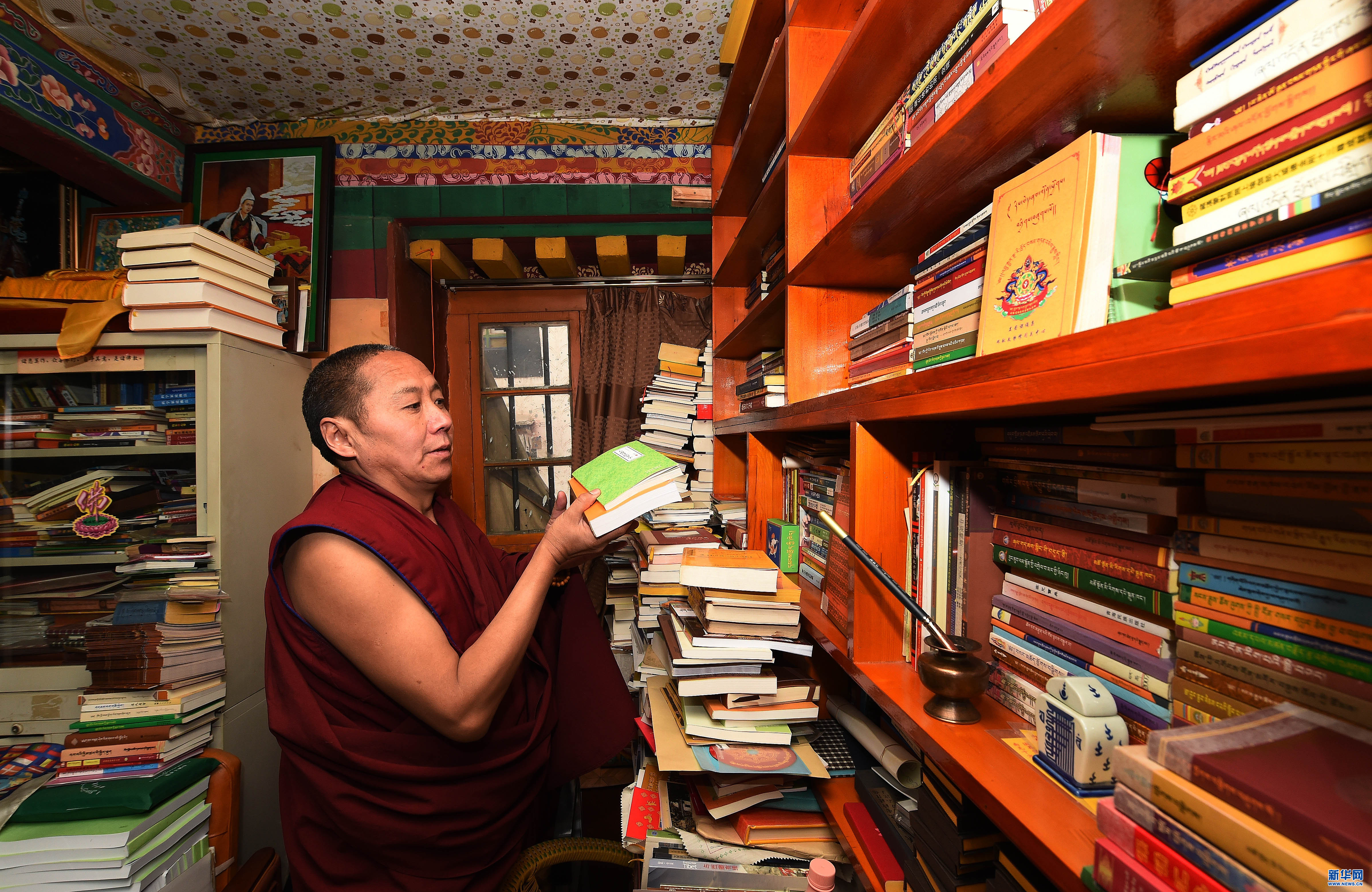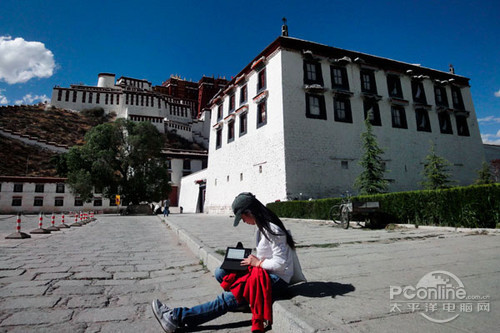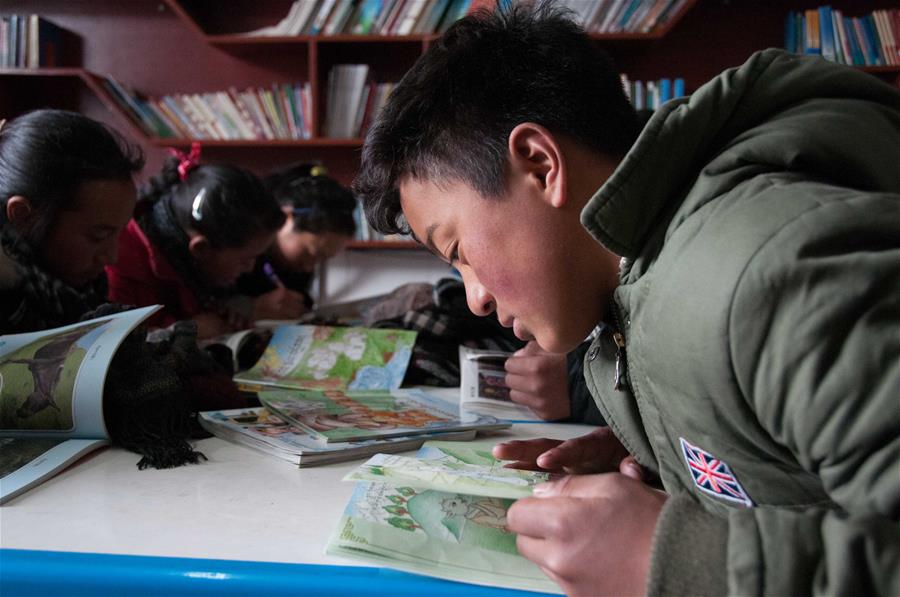A monk who collects books

Photo taken on April 18 shows monk Nyima Tsering’s scripture bookshelf in Jokhang Monastery, Lhasa.

Photo taken on April 18 shows monk Nyima Tsering’s bookshelf in Jokhang Monastery, Lhasa.

Photo taken on April 18 shows monk Nyima Tsering’s scripture bookshelf in Jokhang Monastery, Lhasa.
Forty-eight-year-old Nyima Tsering is a high monk at Jokhang Temple who has a collection of more than 15,000 books, including books on Buddhist philosophy, history, and literature. He is proficient in Tibetan, Chinese, and English, and he has also published several books on the story of Jokhang Temple in Lhasa, folklore in both Tibetan and Chinese, and picture albums.
Nyima Tsering began collecting books in 1985, the year he was officially ordained as a monk. He visits bookstores four or five times a month and never misses an opportunity to purchase books when he travels to the inland. In more than 30 years, Nyima Tsering’s collection has grown to include books on Buddhist philosophy, history, literature, and other subjects.
Nyima Tsering likes to read books at night. He says that there is a lot of work to be done during the day, so it’s hard to find a quiet time to read. Nowadays the monks’ apartments all have electricity, which has increased the efficiency for reading late at night.
While reading, Nyima Tsering has adopted a cutout habit. He showed the reporter a two-centimeter thick scrapbook of clippings, and inside were excellent pictures and writings that record various Buddhist stories and aphorisms of life.
This scrapbook has a history of over 20 years. Some clippings are from newspapers and magazines, while some are written by Nyima Tsering himself, not only in Tibetan script, but also Chinese and English. Nyima Tsering says that he usually reads documents about Jokhang Templeand Tibetan Buddhism, and that by cutting out and saving several clippings, this will provide a reference for future study.
Today, with the developments in science and technology, more and more monks have begun to use mobile phones and other devices to read scriptures. Nyima Tsering has an iPhone, and he will also occasionally read some scriptures on his phone. However, he admitted that he doesn’t get as good a feeling reading scriptures on his phone as he does reading from the paper texts. Aside from eye discomfort, reading from the phone also lacks a peaceful precipitation, and this kind of peace is necessary when reading scriptures.
The more books he bought, Nyima Tsering began to havean idea to start giving out books. “There are many ways to give alms, but the highest forms of alms-giving is to give the Dharma, that is the Buddhist principles and passing along wisdom,” Nyima Tsering said. “Therefore, giving books is also a way to preach to people.”
Since 2012, Nyima Tsering has been using his own money to print 150,000 Tibetan and Chinese bilingual texts of “Prayers and Hymns to Jowo Rinpoche”, presenting them to tourists and Buddhist followers, and he also bought “300 Questions on General Knowledge of Tibetan Buddhism”, “Love From the Wisdom That Comes From the Heart”, and other books from the bookstore, which he gives to people he believes are predestined to have these books.
Nyima Tsering also published a Tibetan, Chinese, and English text of “Jokhang Monastery” based on accurate and reliable information, folk stories, and personal experiences. The book is an easy-to-understand narration on the history and parable of the Buddha statue of Jokhang Temple.
Your Comment
Name E-mailRelated News
-
;
-
-

-
Four Books of Tibetan culture to get national publishing funds
Four Tibetan books cover ancient Tibetan history, Thangka, Tibetan medicine and decorations will be funded nationally for publications.
-
-
-

-
Sichuan brings 56 Tibetan-Chinese bilingual books into classrooms
The Aba Tibetan-Qiang Autonomous Prefecture has compiled 56 Tibetan-Chinese bilingual reading materials and plans to bring them into classrooms.
-
-
-

-
Across China: Bilingual books gain popularity among Tibetan kids
Educational authorities in Sichuan Province, southwestern China, will commission more materials to meet the growing demand for bilingual books.
-
-
-

-
Across China: Bilingual books gain popularity among Tibetan kids
Educational authorities in Sichuan Province, southwestern China, will commission more materials to meet the growing demand for bilingual books.
-
Based in Lhasa, Tibet Vista is a Tibet travel agency that specialized in Tibet permit, and Tibet tours for both private and group travelers at a local price!
•4 Days Lhasa City Group Tour from USD 460 •8 Days Everest Base Camp Group Tour from USD 850 •15 Days Mt.Kailash Group Tour from USD 1780 •2016 Tibet Train Tours from Beijing, Shanghai, Chengdu, Xining,etc










